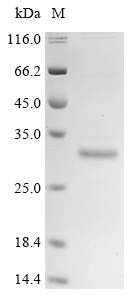The recombinant human FGF21 protein is expressed with the N-terminal 6xHis-tag in E. coli. The gene fragment encoding the 29-209aa of FGF21 protein is cloned into a suitable expression vector. The 6xHis-tag gene is also inserted into the vector. The recombinant vectors are transfected into E. coli cells. Upon IPTG induction, the recombinant FGF21 protein is expressed at high levels and is subsequently purified from the cell lysate using Ni-NTA affinity chromatography. This method takes advantage of the interaction between the 6xHis tag and nickel ions in the resin. Following purification, SDS-PAGE analysis reveals a protein purity exceeding 90%.
Human FGF21 functions primarily as an endocrine hormone, playing a crucial role in the regulation of glucose and lipid metabolism. FGF21 is predominantly expressed in the liver, adipose tissue, skeletal muscle, and other organs, and its secretion is significantly influenced by metabolic states such as fasting and obesity [1][2][3].
FGF21 has garnered attention for its metabolic regulatory functions. It has been shown to enhance glucose uptake in adipocytes and increase insulin sensitivity, making it a potential therapeutic target for metabolic disorders such as type 2 diabetes and obesity [4][5][6]. In experimental models, FGF21 administration has been associated with improved metabolic profiles, including reduced plasma glucose and triglyceride levels, and protection against diet-induced obesity [4][6][7]. The hormone's effects are mediated through its interaction with specific receptors, notably the FGFR1 in conjunction with the co-receptor βKlotho, which is essential for FGF21 signaling [3][8].
Beyond glucose and lipid metabolism, FGF21 has been implicated in the regulation of energy expenditure and thermogenesis, particularly in brown adipose tissue (BAT) [9][10]. FGF21 levels are elevated during fasting, suggesting its role in adapting to energy deficits by promoting fatty acid oxidation and ketogenesis [11][12]. Additionally, FGF21 has been associated with protective effects against oxidative stress and inflammation, which are critical in various metabolic and cardiovascular diseases [13][14].
References:
[1] Y. Ma, Y. Kuang, W. Bo, Q. Liang, W. Zhu, M. Cai, et al. Exercise training alleviates cardiac fibrosis through increasing fibroblast growth factor 21 and regulating tgf-β1-smad2/3-mmp2/9 signaling in mice with myocardial infarction, International Journal of Molecular Sciences, vol. 22, no. 22, p. 12341, 2021. https://doi.org/10.3390/ijms222212341
[2] J. Yie, R. Hecht, J. Patel, J. Stevens, W. Wang, N. Hawkins, et al. Fgf21 n‐ and c‐termini play different roles in receptor interaction and activation, Febs Letters, vol. 583, no. 1, p. 19-24, 2008. https://doi.org/10.1016/j.febslet.2008.11.023
[3] X. Ding, J. Boney-Montoya, B. Owen, A. Bookout, K. Coate, D. Mangelsdorf, et al. Βklotho is required for fibroblast growth factor 21 effects on growth and metabolism, Cell Metabolism, vol. 16, no. 3, p. 387-393, 2012. https://doi.org/10.1016/j.cmet.2012.08.002
[4] J. Lu, H. Yu, Y. Mo, X. Ma, Y. Hao, W. Lu, et al. Patterns of circulating fibroblast growth factor 21 in subjects with and without type 2 diabetes, Plos One, vol. 10, no. 11, p. e0142207, 2015. https://doi.org/10.1371/journal.pone.0142207
[5] F. Fisher, P. Chui, P. Antonellis, H. Bina, A. Kharitonenkov, J. Flier, et al. Obesity is a fibroblast growth factor 21 (fgf21)-resistant state, Diabetes, vol. 59, no. 11, p. 2781-2789, 2010. https://doi.org/10.2337/db10-0193
[6] K. Mai, J. Andres, K. Biedasek, J. Weicht, T. Bobbert, M. Sabath, et al. Free fatty acids link metabolism and regulation of the insulin-sensitizing fibroblast growth factor-21, Diabetes, vol. 58, no. 7, p. 1532-1538, 2009. https://doi.org/10.2337/db08-1775
[7] P. Højman, M. Pedersen, A. Nielsen, R. Krogh-Madsen, C. Yfanti, T. Åkerström, et al. Fibroblast growth factor-21 is induced in human skeletal muscles by hyperinsulinemia, Diabetes, vol. 58, no. 12, p. 2797-2801, 2009. https://doi.org/10.2337/db09-0713
[8] W. Wei, P. Dutchak, X. Wang, X. Ding, X. Wang, A. Bookout, et al. Fibroblast growth factor 21 promotes bone loss by potentiating the effects of peroxisome proliferator-activated receptor γ, Proceedings of the National Academy of Sciences, vol. 109, no. 8, p. 3143-3148, 2012. https://doi.org/10.1073/pnas.1200797109
[9] S. Keipert, M. Kutschke, M. Ost, T. Schwarzmayr, E. Schothorst, D. Lamp, et al. Long-term cold adaptation does not require fgf21 or ucp1, Cell Metabolism, vol. 26, no. 2, p. 437-446.e5, 2017. https://doi.org/10.1016/j.cmet.2017.07.016
[10] S. Keipert, M. Kutschke, D. Lamp, L. Brachthäuser, F. Neff, C. Meyer, et al. Genetic disruption of uncoupling protein 1 in mice renders brown adipose tissue a significant source of fgf21 secretion, Molecular Metabolism, vol. 4, no. 7, p. 537-542, 2015. https://doi.org/10.1016/j.molmet.2015.04.006
[11] T. Inagaki, P. Dutchak, G. Zhao, X. Ding, L. Gautron, V. Parameswara, et al. Endocrine regulation of the fasting response by pparα-mediated induction of fibroblast growth factor 21, Cell Metabolism, vol. 5, no. 6, p. 415-425, 2007. https://doi.org/10.1016/j.cmet.2007.05.003
[12] Y. Zhang, Y. Xie, E. Berglund, K. Coate, T. He, T. Katafuchi, et al. The starvation hormone, fibroblast growth factor-21, extends lifespan in mice, Elife, vol. 1, 2012. https://doi.org/10.7554/elife.00065
[13] S. Kim, K. Kim, H. Kim, M. Kim, S. Back, M. Konishi, et al., Fibroblast growth factor 21 participates in adaptation to endoplasmic reticulum stress and attenuates obesity-induced hepatic metabolic stress, Diabetologia, vol. 58, no. 4, p. 809-818, 2014. https://doi.org/10.1007/s00125-014-3475-6
[14] G. Ferrer-Curriu, M. Guitart‐Mampel, C. Rupérez, M. Zamora, F. Crispi, F. Villarroya, et al. The protective effect of fibroblast growth factor‐21 in alcoholic cardiomyopathy: a role in protecting cardiac mitochondrial function, The Journal of Pathology, vol. 253, no. 2, p. 198-208, 2020. https://doi.org/10.1002/path.5573






